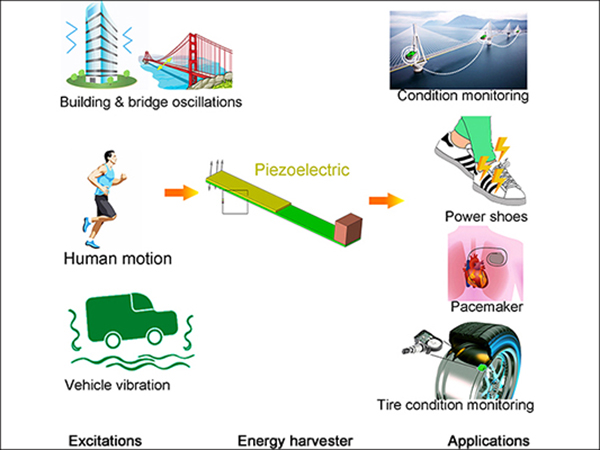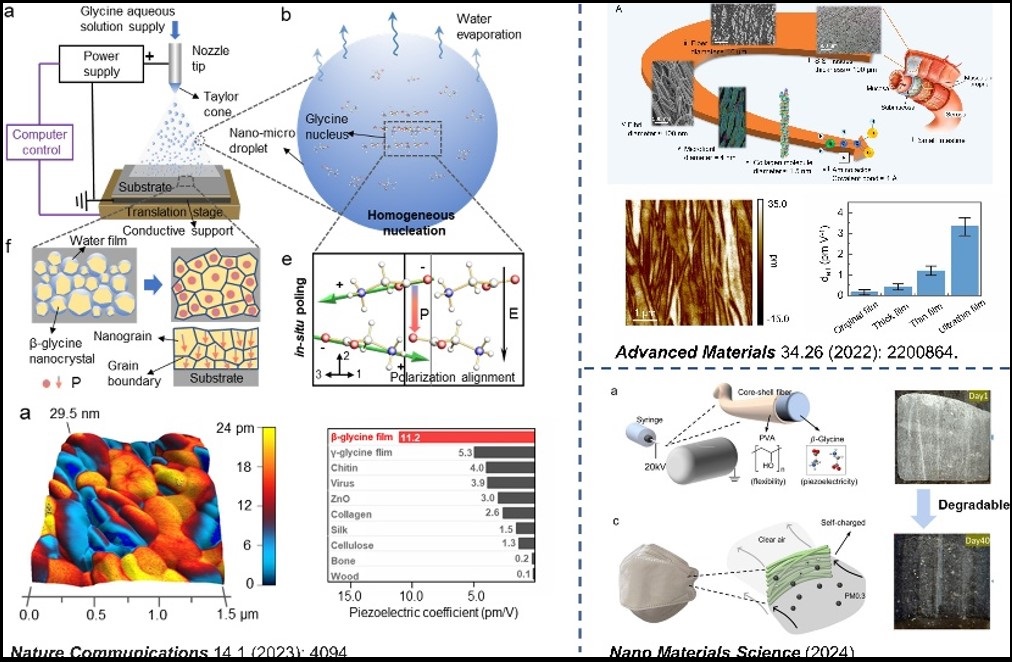
Bio-organic piezoelectric materials
-
Piezoelectric devices made of various inorganic materials or organic polymers have been widely used in electrics, electronics, and biomedicine. Unfortunately, such synthetic materials are generally rigid, fragile, challenging to process, toxic to organisms, and considered electronic wastes for their non-biodegradability. Piezoelectric biomaterials are promising alternatives for biomedical and sustainable applications due to their natural biocompatibility, biodegradability, resorbability, reliability, and environmental friendliness. However, due to the high cost and complexity of assembling and domain aligning the small biomolecules at a large scale, most of the research on their biological piezoelectricity is still at the theoretical level. Additionally, because of the disorder of domains and the lack of ferroelectricity, biological tissues hardly exhibit piezoelectric properties at the macroscopic level.
To address these challenges, we have recently made a series of groundbreaking research breakthroughs in understanding the origin of biopiezoelectricity and manufacturing high-performance piezoelectric biomaterials, which have been published in Nature Communications, Ref 1 , Advanced Materials, Ref 2, Nano Materials Science, Ref 3.
We envision our invented biomaterials will have wide-ranging applications in biomedical fields, including health monitoring, disease diagnosis, drug delivery, cancer treatment, tissue regeneration, neural trauma therapy, and anti-fouling treatment.
High-Performance Energy Harvesting and Its Applications
With the rapid advances in wireless sensors, implantable electronics and wearable devices, the demand for high-power-density and long-lifespan power sources is becoming increasingly stronger. Energy harvesting, emerging as an alternative energy solution to batteries, holds great potential to achieve self-powered autonomous operations of such low-power electronic devices, and thus has attracted much attention from both academia and industry recently. We present a comprehensive and critical review of state-of-the-art research on piezoelectric energy harvesting. From the viewpoint of applications, we are most concerned about whether an energy harvester can generate sufficient power under a variable excitation. Therefore, here we concentrate on methodologies leading to high power output and broad operational bandwidth. A variety of designs, nonlinear methods, optimization techniques and harvesting materials are reviewed and discussed in depth. The study also evaluates different figures of merit and presents a systematic performance comparison on recently-proposed energy harvesters. Furthermore, we identify four promising applications: shoes, artificial pacemakers, tire pressure monitoring systems, and bridge & building monitoring.
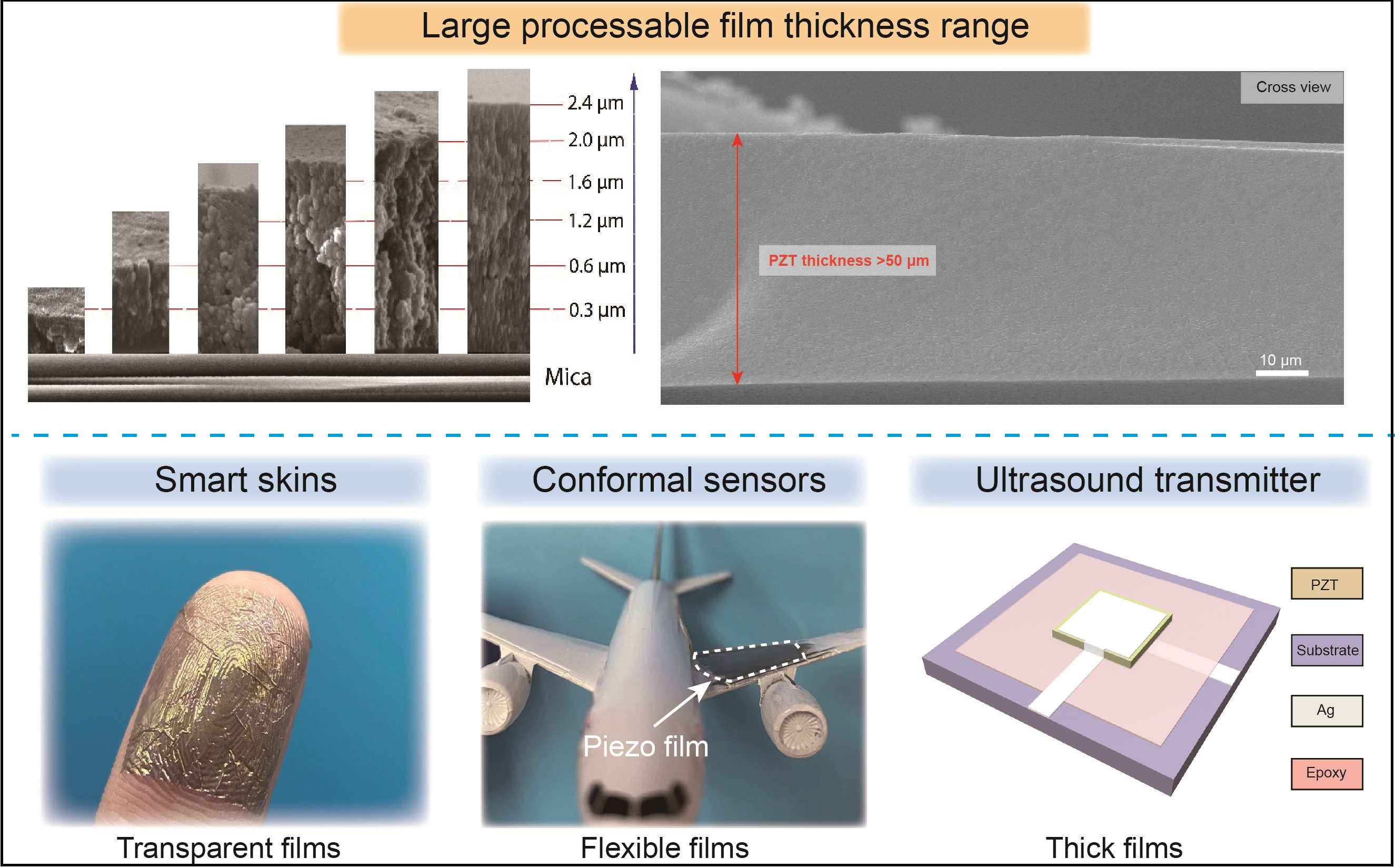
Piezoelectric Thin Films and Devices
-
Piezoelectric ceramic has served as a significant role in sensors and energy harvesters for decades years. With the continuous development of electronic devices in the direction of miniaturization and flexibility, conventional piezoelectric ceramics that are brittle and non-stretchable are no longer suitable. Novel piezoelectric films can effectively solve the problems. We fabricate piezoelectric thin films on arbitrary substrates via the sol-gel method and the magnetron sputtering system. We theoretically and experientially study their perovskite structures, ferroelectric features, the polarization and electromechanical coupling. A variety of patterned electrodes are fabricated onto the surface of thin films for different application scenarios, such as energy harvesting, biomedical sensors, artificial skin and robots, contributing to the development of flexible electronics and artificial intelligence (AI).
Material: PZT; AIN; ZnO; BaTiO3; LiNbO3; PMN-PT; BCZT; BTO-BFO; KNN
Film thickness range: 50 nm – 10 um
Application: energy harvester; bio-sensor; e-skin; soft robot; MEMS sensor & pump; RF filter; Resonator; Surface Acoustic Wave Sensors;
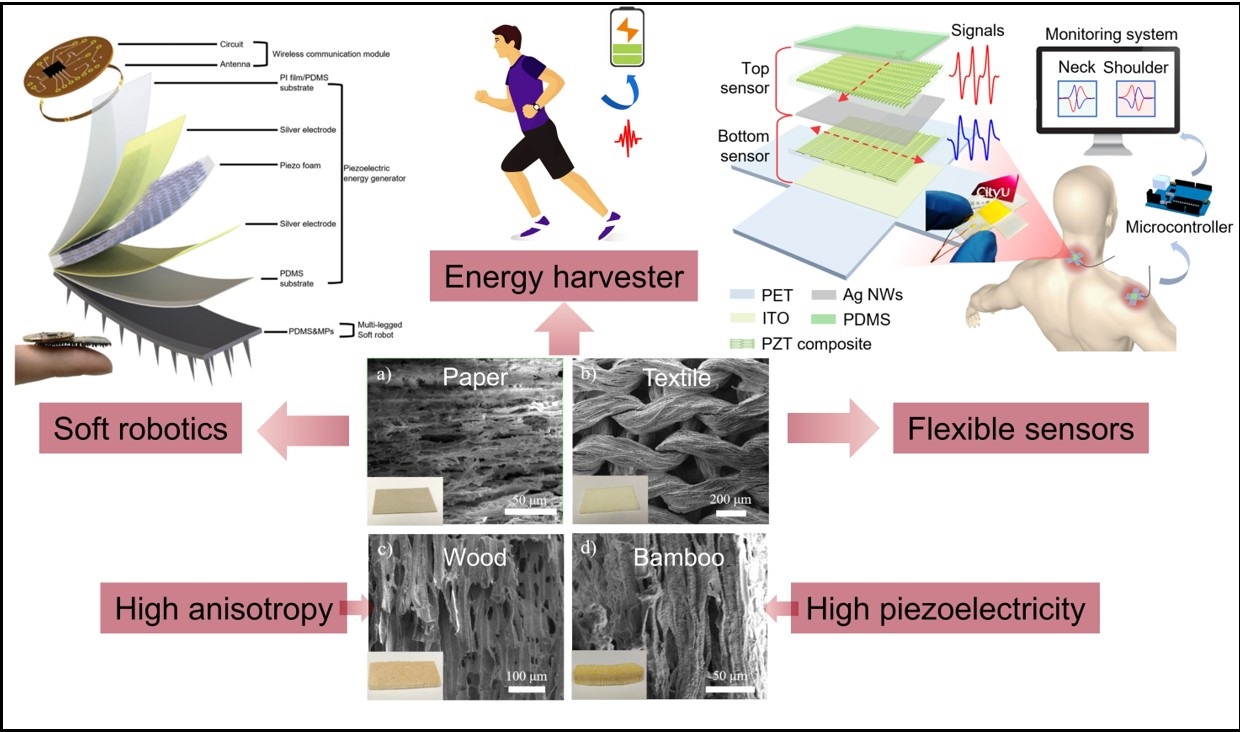
Piezoceramic Composite and Devices
-
The conflict of flexibility and high piezoelectricity has triggered extensive research on flexible piezoelectric materials. Multiple research endeavors have been made by mixing piezoceramic powders in soft polymer substrates. The weak force coupling in these ceramic-polymer composites significantly impairs the equivalent piezoelectric properties. To solve these problems, our group design and fabricate new 3D interconnected piezoceramic composites that are highly piezoelectric and flexible. Furthermore, We have fabricated 3D-structured piezoelectric composites based on different templates, such as paper, fabrics, wood, and bamboo. The different patterns in these templates determine the distribution of a self-connected state of a component, leading to the unique anisotropic piezoelectric properties. The developed piezoceramic composites demonstrate potential applications in soft robotics, flexible sensors, and energy harvesters.
Self-powered Wireless Automotive Sensors
With recent developments of the automotive industry, particularly in terms of continuously variable transmission (CVT) and hybrid electric vehicle (HEV), electric cars and self-driving technologies, more and more sensors are being used to achieve better driveability, greater safety, and higher fuel efficiency.
We are developing self-powered and wireless sensor modules for next-generation intelligent vehicles. Specifically, we are working on two projects: 1) self-powered tire condition monitoring systems; 2) self-powered torque monitoring systems in the powertrain of vehicles.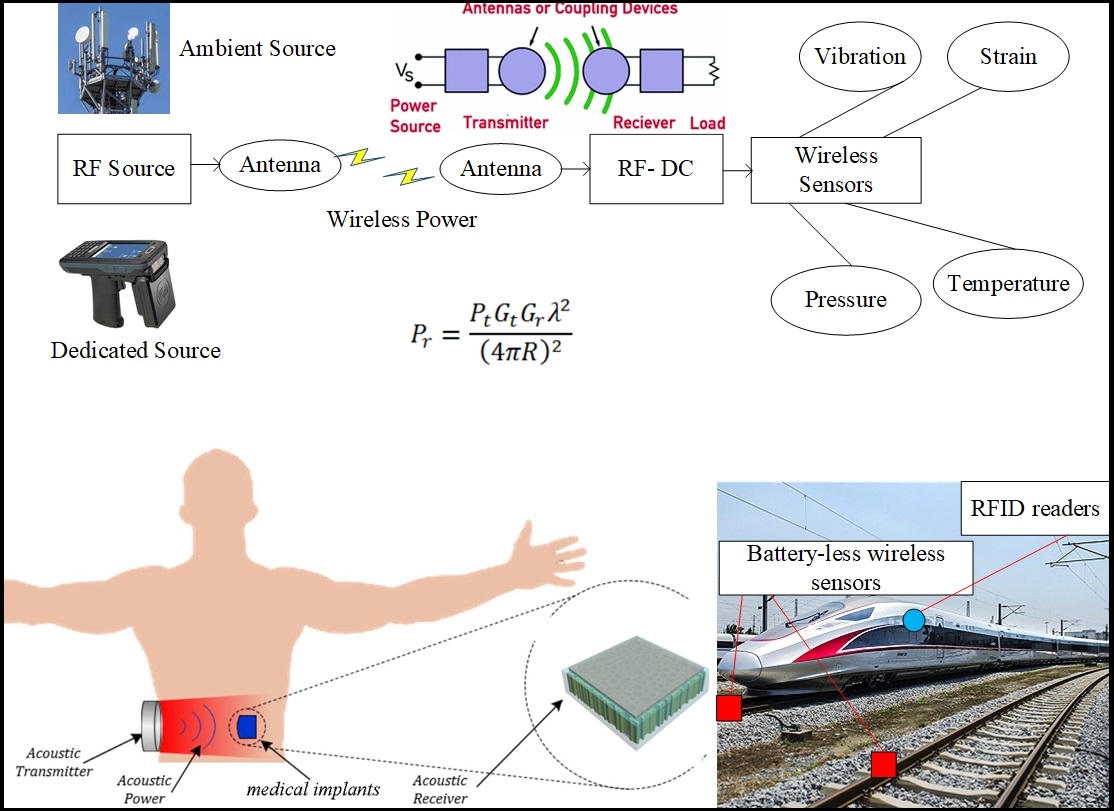
Electromagnetic and Acoustic Wireless Power Transfer
-
Starting from Nickola Tesla's wireless power transfer by inductive and capacitive coupling in the 19th century, humans have been dreaming of getting access to free electricity at any time and anywhere. In the past two decades, driven by the rapid development of consumer electronics, the Internet of Things, and medical devices, the wireless power transfer technology has attracted much attention from both academia and industry. Wireless power transfer (WPT) helps to get rid of the limitations from batteries and wire connections and is expected to bring a long lifespan and low maintenance cost of diverse applications.
Our group has been working on wireless power transmission via electromagnetic waves, and acoustic waves. Both short-range transmission of a few centimeters and mid-range up to a few meters have been explored. For example, we have developed an RFID-based self-powered wireless sensor module for railway condition monitoring. Details can be found in Ref. We also have developed a wood-mimetic acoustic transducer and its system that can wireless transfer power through skin, muscle, and bones, which can be used for powering medical implantable devices.
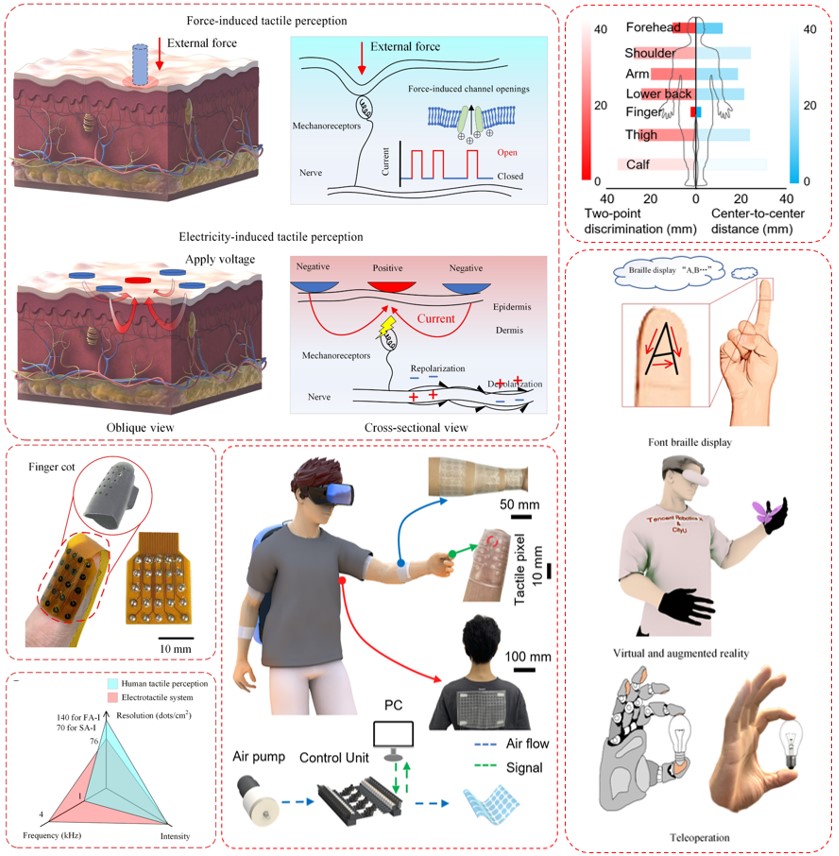
Flexible sensors and tactile/haptic system
-
Human skin is a very amazing sensor that enables simultaneously detecting the intensity and modes of diverse stimuli, including pressing, tapping, slipping, and bending. The disabled without limbs suffer much from the lack of tactile sensing capability. We developed a piezoelectric flexible multifunctional tactile sensor array that can sense and differentiate the magnitude, positions, and modes of diverse external stimuli in real time. Furthermore, develop a simple but effective electrode topology that is crosstalk-free and only requires n + m wires for an n × m sensor array Ref.
Haptic technology can create an experience of touch by applying forces, vibrations, or motions to end users. The human somatosensory system is capable of extracting features with millimeter-scale spatial resolution and sub-milli-second temporal precision. Current technologies that can render tactile stimuli with such high definition are neither portable nor easily accessible. We collaborated with Tencent and developed a wearable electro-tactile rendering system that elicits tactile stimuli with both high spatial resolution (76 dots/cm2) and rapid refresh rates (4 kHz) [Science Advances] . Our new pneuma-tactile rendering system provides 200-2300 μm deformation and pressure of 150-2400 mN;depending on the tactile sensitivity of different parts of the human body. The two systems are used as braille rendering that allows the visually impaired to use the same system to read and write as a normal person. We envision that our technology will benefit a broad spectrum of applications such as information transmission, surgical training, teleoperation, and multimedia entertainment.
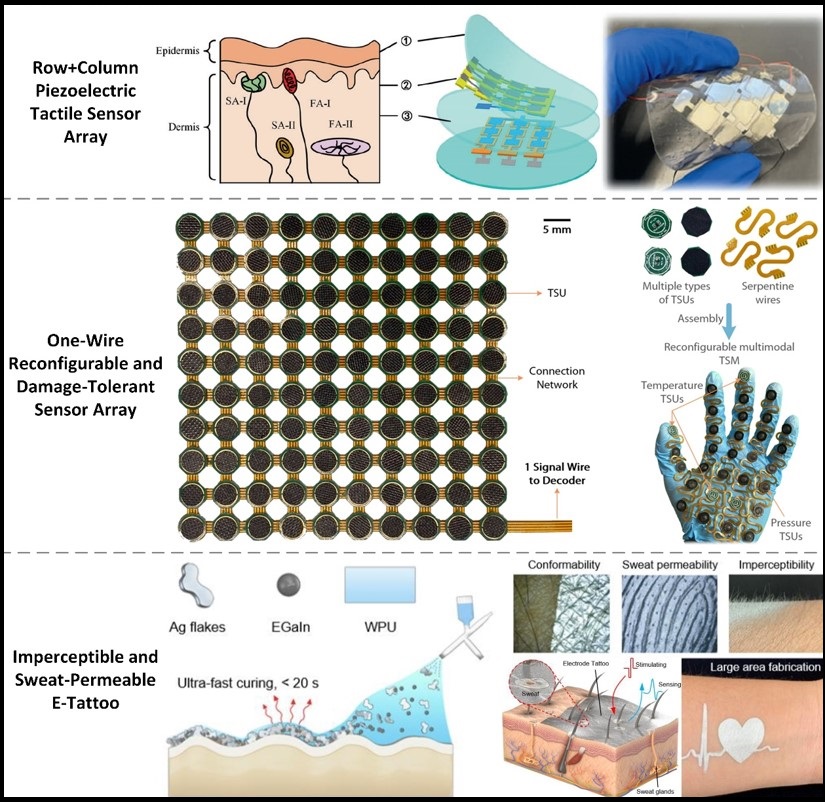
Flexible sensor array and E-Tattoo
-
Flexible sensor arrays are engineered to detect a broad spectrum of stimuli, including pressure, sliding, temperature, and strain, proving to be crucial in various applications such as robotics, aviation, and medical devices. However, conventional flexible sensor arrays often face challenges with complex wiring, poor reconfigurability, and vulnerability to physical damage.
Our team's innovative designs significantly improve upon these limitations. We developed a tactile sensor array that resembles human skin, simplifying the grid wiring to a row-column configuration and eliminating crosstalk. This enables real-time differentiation of stimulus size, location, and type. Additionally, our proposed tonotopy-inspired sensor matrix (TSM) platform mimics the auditory system's frequency mapping by assigning unique sine wave frequencies to sensor units for parallel signal processing through a single conductor. The real-time Fast Fourier Transform (FFT) algorithm deconstructs the composite signal into a spectrum representing all sensor information, allowing for diverse multi-sensor applications. This design ensures reconfigurability and damage tolerance, with flexible configurations adaptable to various fields. This is published in Science Advances and featured on the cover page.
We also engineered an imperceptible and sweat-permeable E-Tattoo, a spray-on technology specifically designed for hairy skin. It seamlessly monitors biopotential signals such as ECG and EMG with high precision and allows for subtle electrical stimulation.
Porous Films and Filtration Technology
We develop differnt manufacturing systems, such as electrospinning,electrospraying, sputtering, evaporation, etc, to fabricate porous thin films for air and water filtrations. Below is one project conducted in 2021-2022.
Electrostatic adsorption is an important complement to the mechanical filtration for high-efficiency air filtering. However, the electrostatic charge decays with time, especially in humid conditions. In this work, a self-charging air filter is presented to capture airborne particles in an efficient and long-lasting manner without the need of external power sources. Leveraging the triboelectric effect between the electrospun poly(vinylidene fluoride) nanofiber film and nylon fabric, the self-charging air filter-based mask excited by breathing can continuously replenish electrostatic charges. As a result, its effective lifespan is up to 60 hours, with a minimum filtration efficiency of 95.8% for 0.3-μm particles. The filtration efficiency and lifespan are significantly higher than those of a commercial surgical mask. Furthermore, we uncover the quantitative relation between filtration efficiency and surface electrostatic potential. This work provides an effective strategy to significantly prolong the electrostatic adsorption efficacy for high-performance air-filtering masks. This work is published on Nature Communications Ref.,and is selected to The Editors’ Highlights Ref. .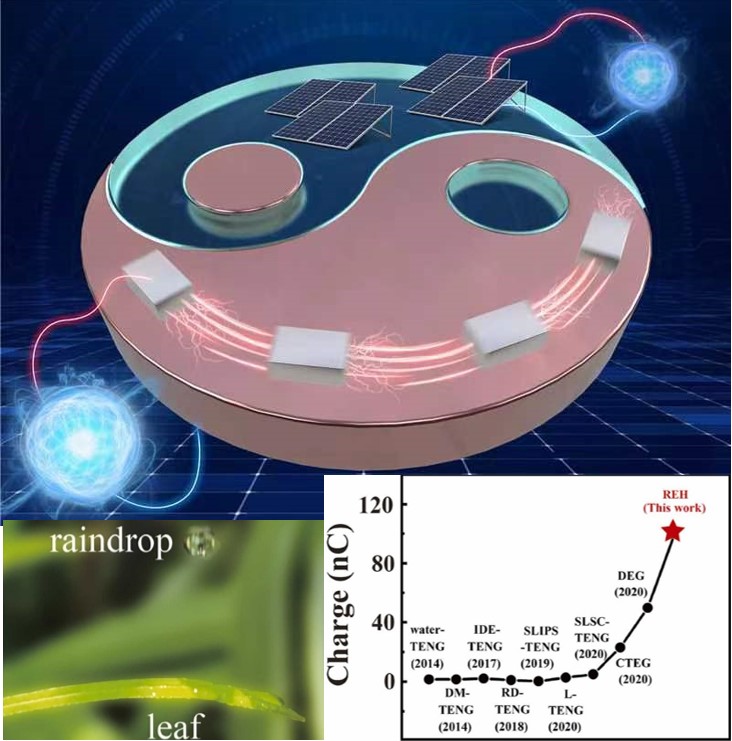
Triboelectric Effect and Interface Science
-
Triboelectric nanogenerators (TENGs) convert mechanical energy into electrical energy utilizing the triboelectric effect and electrostatic induction. While traditional TENGs employ insulating materials as triboelectric layers, the utilization of non-insulating materials presents unique properties and advantages. For instance, the water-polymer interfaces exhibit the transistor-inspired bulk effect, renowned for its exceptional electricity-generating performance. Furthermore, semiconductor-based interfaces demonstrate the tribovoltaic effect, which generates a direct current. The related research has been reported by Energy & Environmental Science [1], [2].
We have explored various devices and applications for high-performance droplet energy harvesting and proposed a new “triboelectric junction” model to interpret the tribovoltaic effect. Our work encompasses multiple disciplines, including materials science, device engineering, application development, and physics. By delving into these areas, we aim to make fundamental discoveries and uncover potential applications for triboelectric nanogenerators.
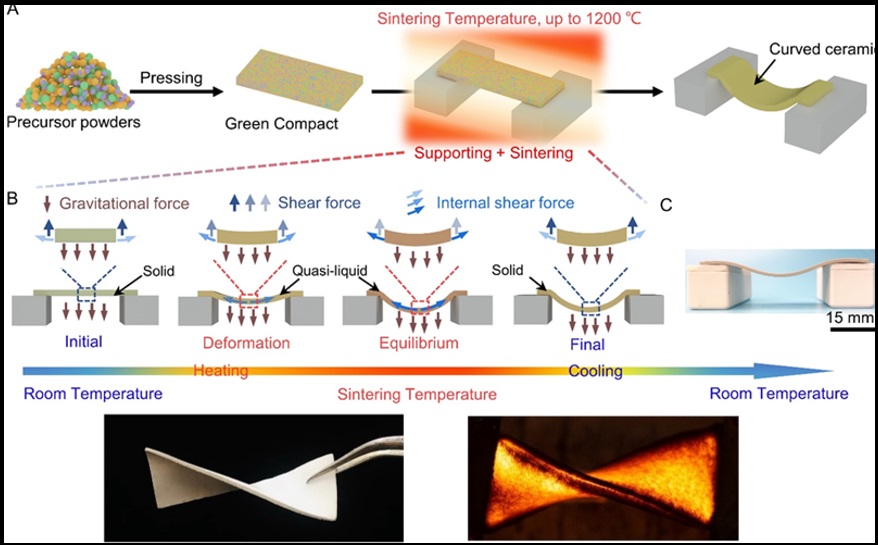
Fast sintering and 3D ceramics
-
Bulk piezoceramics are important functional materials and widely used in electronics and energy devices, thanks to their high electromechanical coupling effect, stable mechanical properties, good thermal stability, and low cost. Piezoceramic components are usually formed to planar shapes such as plates and discs due to their poor processibility that originates from the strong covalent bonds between constitutive atoms. We fabricate high-performance piezoceramics in complex shapes, we prepare various complex shape piezoceramics via exploiting the thermal creep phenomenon of ceramic powder compacts during heating and sintering Nature Comm., and Materials Today.
Nonlinear Vibration and Compressive-mode Piezoelectric Energy Harvesting
Energy Harvesting is renewable energy technology.
The piezoelectric effect is widely adopted to convert mechanical energy into electrical energy, due to its high energy conversion efficiency, ease of implementation and miniaturization.
These projects are to explore new ways to improve the power output and extend the frequency bandwidth of piezoelectric energy harvesters (PEHs). Our study indicates that the compressive operation mode of piezoelectric materials is better than other modes in terms of generating high energy. Compressive-mode prototypes generated a highest power output of ~ 50 mW [Ref], which is enough to power most potential applications. Nonlinear vibration is used to extend PEH's bandwidth [Ref]. A reversible hysteresis is achieved in experiments [Ref], which effectively extend the bandwidth in both directions. We have systematically analyzed the energy flow and efficiency of energy harvesting systems [Ref], studied new single-crystal PMN-PT materials [Ref] and developed SSHI power conditioning circuits [Ref].
Vibration Isolation of a Massage Device
-
This is an interesting project, funded by a company in Canada. Percussion massagers are widely used to relieve the pain of muscles. They are used for both humans and animals (e.g., horses). The major function of these handheld tools is to generate vibrations and pressures on muscles, but they also generate reactive force on the physical therapist who holds it. This project is to reduce the reactive oscillating force on hands. We studied the vibration responses of the system theoretically and experimentally and proposed different vibration damping and isolation methods. The re-designed massage device is much easier to be used compared with the old one.
Shape Memory Alloy Actuators and Biomimetic Robots
-
Autonomous Underwater Vehicles (AUVs) have a wide range of applications in marine geoscience and are being used in the military, commercial, policy and scientific sectors. Most AUVs employ traditional screw propeller have some innate weaknesses: low-efficiency, complexity, relative bulky volume and weight, acoustic noise, etc. Inspired by the elegant and agile swimming pattern of fish, we developed a biomimetic sailfish robot. As shown in the figure, we designed a soft and high-efficiency fin propulsor using shape memory alloys, designed a control circuit based on PIC microcontrollers, and conducted a systematic CFD analysis and experimental tests. We also invented a novel two-tail fish robot [Patent].
